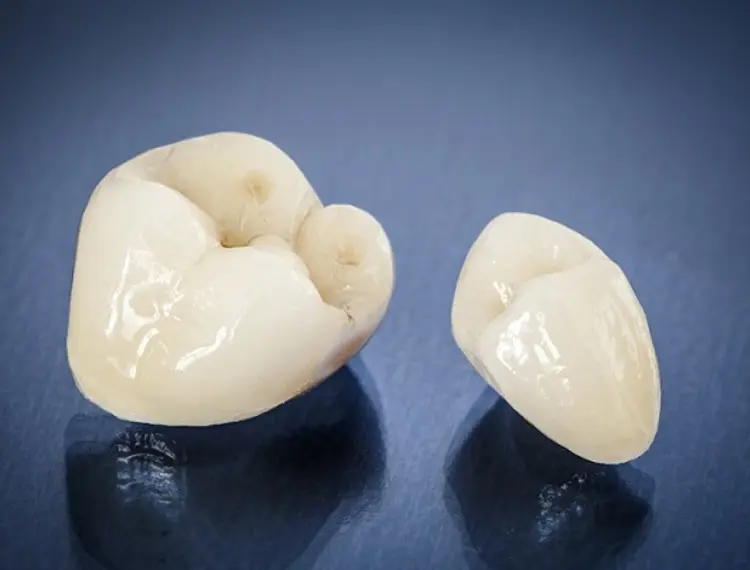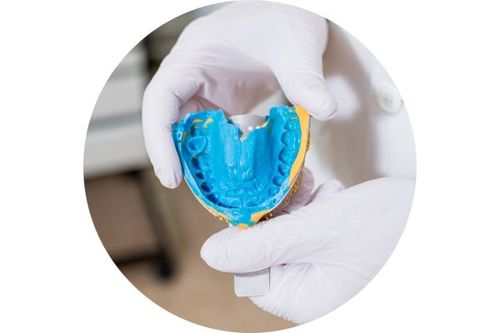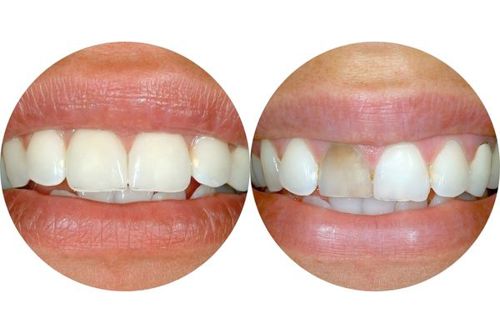
Key messages
- Cosmetic dental treatments can be done by a dentist or dental specialist, called a prosthodontist.
- A dentist cannot be registered as a Cosmetic Dentist in Australia.
- Crowns, veneers and bridges can improve the function and appearance of teeth.
- Having a crown, bridge or veneer does not mean no treatment will ever be required again for the tooth or teeth.
Crown, bridge and veneer treatments are elective treatments that may be performed to fix damaged teeth but can also be used to change the visual appearance of teeth. These treatments can be done by a general dentist or a dental specialist, called a prosthodontist.
Dental crowns
A crown may be recommended by a dentist to fix a badly broken, cracked or decayed tooth. They are commonly recommended for teeth that have had a root canal treatment, particularly for premolar and molar teeth.
Artificial crowns are created to fit over the natural tooth after it has been cut back. They can make the tooth stronger and protect the tooth inside the crown. They can also improve the appearance of the tooth or teeth.
Crowns can be made from a number of materials including porcelain, zirconia, gold alloy or a combination of porcelain and metal. The colour of the porcelain and zirconia can be matched to the colour of your other teeth.
Treatment often takes two appointments with your dentist. In the first appointment the dentist will cut back the tooth to reshape it. This is to make sure there is enough space for a new crown to fit on the tooth.
Your dentist needs a copy of your tooth shape to send to a laboratory for a dental technician to create the crown. There are two ways the copy of the tooth may be completed:
- An impression is taken using a jaw-shaped tray filled with a soft, gel-like material that is pushed onto the teeth and held in place for three to five minutes.
- A digital scanner is used to take a 3-dimensional (3D) image of the tooth.

The impression or 3D image is provided to a dental technician who makes the crown. If you are receiving a tooth-coloured crown, your dentist will work with the technician to ensure the colours and any special features match your other teeth as best as possible.
Before leaving this first appointment, your dentist will put a temporary, plastic crown over the reshaped tooth.
On the second visit, the temporary crown is removed from the tooth. The new crown is glued or cemented onto the natural tooth structure.
Some dentists now provide same-day crowns where treatment is provided from start to finish in one day.

Before, during treatment and after crowns are placed on the six front teeth. Getty Images.
Dental bridges
A dental bridge replaces one or more missing teeth. If you have a tooth removed, your dentist may suggest a dental bridge as a replacement option.
Most commonly, this treatment involves placing a crown on the teeth that sit directly in front and behind the gap. These crowns are joined together by another crown that acts as a false tooth.
Similar to the treatment for a crown, a dental bridge usually takes two appointments and is also able to be made from porcelain, zirconia, gold alloy or a combination of porcelain and metal. At the first appointment, your dentist will reshape the teeth located each side of the gap ready for the bridge to be made at a dental laboratory. At the second visit, the treatment is completed by gluing or cementing the manufactured bridge onto the reshaped teeth. In between the visits, an acrylic (plastic) bridge will be temporarily glued to the reshaped teeth to protect them.
A bridge is just one option available to replace a missing tooth. Other treatments to replace one or more missing teeth include partial dentures and dental implants. Each treatment has benefits. The benefits of each treatment should be discussed with your dentist to find the treatment suitable for you.

Dental veneers
A dental veneer is made of a thin shell of porcelain or white filling material, called composite resin, which is glued to the front surface of the tooth. Depending on the reason for the treatment, veneers may be placed on one or multiple teeth.
Dental veneers are very thin, meaning not much or no tooth structure has to be cut away from the tooth or teeth for the treatment to be completed. The dentist will match the colour of the veneers with the surrounding teeth to make the veneers appear as natural as possible.
This treatment may be a suitable option if you have:
- Gaps between the front teeth that you would like to close but your teeth are otherwise straight,
- Teeth that are stained, discoloured, broken or chipped,
- Slightly crooked teeth, or,
- Teeth that are shaped oddly compared to the other teeth present, for example peg lateral incisors.

There are two types of dental veneers - composite resin veneers and porcelain veneers.
Composite resin is the white filling material used to fill cavities. It is applied directly to the front surface of the tooth and shaped by the dentist. This treatment is usually completed in one appointment but may require a follow up appointment if veneers are placed on multiple teeth. The veneers are created by the dentist while you are in the dental chair.
Porcelain veneers are made by a technician in a dental laboratory. Similar to crowns and bridges, the dentist takes either an impression or a 3D scan to send to the dental laboratory. These veneers are made in the laboratory and then sent back to the dentist who glues the veneers to the surface of the teeth. This treatment usually needs at least two appointments.
Caring for your crowns, bridge or veneers at home
Teeth with crowns, bridges or veneers need to be well cared for to help them last as long as possible. Brush twice per day with fluoride toothpaste and clean between your teeth every day.
As the crowns that make a bridge are joined together, floss cannot be passed between the teeth. Your dentist should show you how best to clean beneath your dental bridge. This may involve using superfloss, floss threaders or interdental brushes.
Will I need more treatment in the future?
Having a crown, bridge or veneer does not mean no treatment will ever be needed again for the tooth or teeth. These teeth can still be damaged by tooth decay. Sometimes crowns, bridges and veneers can chip, fracture or no longer match the colour of your teeth and need to be replaced.
If you are interested in crown, bridge, or veneer treatments, talk to your dentist about if the treatment is right for you. They can provide advice on treatment options and what is suitable for you.


